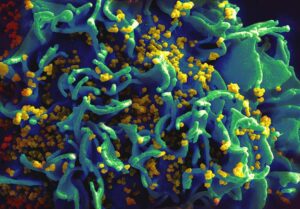Although semaglutide (Ozempic, Wegovy) and other GLP-1 drugs have rapidly become infamous for a wide variety of common side effects, from diarrhea to “Ozempic face,” the most prominent warnings on their official U.S. Food and Drug Administration (FDA) labels alert users to a small number of rarer but more serious adverse events. These more severe complications include gallbladder disease, kidney disease, allergic reactions, pancreatitis, and thyroid cancer.
All these adverse events are considered rare, and experts doubt that some are legitimately caused by GLP-1 drugs. But it’s important to know the warning signs and prevalence of these uncommon Ozempic side effects.
“Gallbladder events are real,” says Daniel Drucker, MD, an endocrinologist and a professor of medicine at the Lunenfeld-Tanenbaum Research Institute in Toronto.
GLP-1 drugs are especially associated with two related gallbladder conditions, cholelithiasis and cholecystitis:
- Cholelithiasis is the formation of gallstones. While some gallstones will sit harmlessly inside the gallbladder, for a minority of patients they will block the release of bile.
- Cholecystitis, or inflammation of the gallbladder, usually results from the formation of gallstones. It causes a variety of uncomfortable or painful symptoms, and can be dangerous in severe cases.
Cholecystitis is generally felt in attacks lasting two or three days. Symptoms include sharp abdominal pain, pain near the shoulder blades, jaundice, dark urine, clay-colored stool, and gastrointestinal discomfort such as nausea, bloating, and vomiting. These symptoms may be worse after fatty meals, which require the release of more bile.
A clinician can confirm the presence of gallstones with an imaging test. Medication can help break up gallstones, but in some cases surgery to remove gallstones is necessary. In the most severe cases, gallbladder removal (cholecystectomy) is an option.
Fortunately, these complications are relatively rare. “It might be one in a few hundred” patients who experience a gallbladder condition due to GLP-1 drug use, says Dr. Drucker.
On the FDA label for Ozempic, “acute kidney injury and worsening of chronic renal failure” is listed as a potential adverse reaction.
This may be counterintuitive, as it seems clear that GLP-1 drugs have overwhelmingly positive effects on kidney function. The latest data suggests that, in patients with type 2 diabetes and chronic kidney disease, Ozempic slashes the risk of kidney failure, substantial loss of kidney function, or death from kidney causes by 24 percent. It is not yet entirely clear if GLP-1 drugs improve the kidney directly or if most of the benefit is a result of weight loss.
“Reports of acute kidney injury are almost always associated with not eating and drinking,” says Drucker. “Please call [your clinician] if you’re not eating or drinking for 24 to 36 hours.”
There have been reports of patients who are hypersensitive or allergic to GLP-1 medications. The reactions have included the following symptoms:
- Urticaria (hives)
- Eczema
- Rash
- Angioedema (swelling beneath the skin)
- Anaphylaxis
For some people, antidrug antibodies and allergic reactions may be provoked by inactive ingredients in a medication. In these cases, a clinician may be able to prescribe an acceptable alternative delivery method prepared by a compounding pharmacy, but users are advised to be very careful when choosing their own supplier.
Ozempic’s FDA label warns that pancreatitis has been reported in clinical trials, and that anyone experiencing pancreatitis should permanently discontinue using the medication.
But the expert consensus is now that semaglutide and other GLP-1 drugs do not increase the risk of pancreatitis, says Drucker.
There’s a second issue: GLP-1 drugs can trigger the release of enzymes that are associated with pancreatic disorders.
“Now we have much more data and we really don’t see an increase in pancreatitis standing out with the GLP-1 medicines,” says Drucker.
Pancreatitis Symptoms
On the official Ozempic label, the FDA reports that pancreatitis is characterized by “persistent severe abdominal pain, sometimes radiating to the back and which may or may not be accompanied by vomiting.” Additional symptoms of pancreatitis may include fever, elevated heart rate, and greasy or yellow stool.
Acute pancreatitis usually comes on quickly, and typically lasts only a handful of days. The disease may require an extended stay in the hospital. In a minority of cases it can lead to severe outcomes, including death.
Chronic pancreatitis, in which the symptoms do not improve, or they keep reoccurring, is usually associated with alcohol abuse.
There is no evidence that Ozempic or other GLP-1 drugs increase the risk of pancreatic cancer.
“We’ve started to see this now over and over again,” says Drucker. More real world data suggests that GLP-1 drugs, which are reputed to aid the body’s cancer killing cells, may reduce the risk of colorectal, prostate, and liver cancer, too, says Drucker.
The FDA labels for Ozempic, Wegovy, Mounjaro, and Zepbound all include a black box warning about the risk of thyroid C-cell tumors. This is the highest and most prominent safety-related warning that the U.S. government adds to drug packaging.
Within the black box, the FDA explains that the medications cause rodents to develop thyroid C-cell tumors, but that it is “unknown” whether the same occurs in humans. The FDA continues to explain GLP-1 drugs should not be used “in patients with a personal or family history of medullary thyroid carcinoma or multiple endocrine neoplasia syndrome type 2 (MEN 2).”
Today, experts agree that there is no real risk of thyroid cancer associated with GLP-1 drugs. Elizabeth Pearce, MD, an endocrinologist and thyroid specialist at Boston Medical Center, says that “Unequivocally, we do not see the same effects in humans as we do in rodents.”
It is plausible that the data has not yet revealed an increased risk of thyroid cancer, which can take a long time to develop. “If it’s real,” says Pearce, “it’s probably very very rare and very low risk.”
Nevertheless, Pearce suggests that American clinicians will likely continue to follow prescribing guidelines “for medical-legal reasons, if nothing else.” Fortunately only a tiny minority of people are affected by this warning. “It doesn’t exclude a whole lot of patients, remembering that the prevalence of medullary thyroid cancer and MEN 2 in the general adult population is somewhere between 1 in 30,000 and 1 in 40,000.”
Pearce adds that patients and doctors alike should not be unduly concerned by any possible effects on the thyroid. “We should not be screening for thyroid nodules before or during GLP-1 receptor agonist treatment just because the patients are on these medications.”
Most of the data shared above was collected from studies of semaglutide and other GLP-1 drugs. There is less known about tirzepatide (Mounjaro, Zepbound) because it is the newest member of this drug family. There simply has been less long-term study of tirzepatide, both in clinical and real-world settings.
Today, tirzepatide carries similar or identical warnings against severe side effects on its FDA labels. Users are warned about thyroid cancer, pancreatitis, kidney problems, gallbladder disease, and allergic reactions.
Uniquely in this drug class, tirzepatide is a dual agonist. Like semaglutide, it mimics the activity of the hormone GLP-1, but it additionally mimics the activity of a second hormone named GIP. This may be the key to its remarkable efficacy. At its highest doses, tirzepatide causes considerably more weight loss than the highest doses of semaglutide.
GLP-1 side effects are generally dose-dependent: reactions are more frequent and more severe at higher doses. But tirzepatide, despite its strength, doesn’t necessarily entail a higher risk of these rare severe side effects. In fact, the opposite may be true. “There is some intriguing data suggesting that GIP, at least in animals, does mitigate some of the adverse events that can be induced by GLP-1,” says Drucker. Based on what we know so far, tirzepatide is probably no more likely to cause any of the rare and severe side effects discussed in this article.
The new generation of GLP-1 drugs for type 2 diabetes and weight loss carry some frightening warnings on their official labels. There’s an emerging expert consensus that some of these side effects — particularly pancreatitis and thyroid cancer — aren’t actually caused by Ozempic or other drugs in the class. But gallbladder disease, acute kidney injury, and allergic reactions are real possibilities, and a good reminder to be very cautious with the side effects caused by these powerful medications.











Post Comment